Carnation is one of the brightest and charming flowering plants that can be found in the garden or flower garden of any country in the world. This flower attracts your charming appearance and wonderful aroma and wins the love of a huge amount of gardeners. In many countries, cloves give various features and make it a symbol of exploits and courage. On the territory of Russia, this flower also had the honor to symbolize the victory and courage. Therefore, it is difficult to find in the CIS countries of a person who would not like these gentle and bright flowers, like small asterisks adorning any plot.
In this article, we will consider in more detail the features and description of the cloves, as well as select the characteristic features of various types and varieties of this beautiful flower. We will introduce you to the main nuances of agrotechnics of growing cloves in their plot.
Content
Features and description of cloves
Carnation is a grassy annual, two-year or perennial plant, which belongs to the clove family. The natural habitat of this flower is considered the territory of Asia, North Africa and Europe. However, the fame of the carnation flower received almost all over the world. There are a large number of legends and legends about him, assign healing and miraculous forces to him.
Translated from the Latin Dianthus this flower indicates the "Flower of Zeus" or a divine flower. And not in vain, because his beauty can conquer anyone, and in antiquity this flower symbolized luxury and aristocracy. One of the ancient Greek legends, this flower appeared after the atrocities of the Goddess of Artemis Hunt. During her hunting on wild beasts, the shepherd swirls prevented her and scared her prey. The goddess got angry and pulled his eyes to him. However, later she repent and could not stand the look of these eyes. Artemis threw them onto a path, after which they turned into two bloody-red flower, which so remind shed blood. Some varieties of carnations core is very similar to the pupil eye.
Mention of cloves can be traced from the 13-14th century, when this flower was very popular among the royal families of Italy and France. This culture is massively divorced and spread all over the world from the 16th century, when it began to cultivate in Holland.
Carnation description:
- The carnation is predominantly a herbaceous plant, although there are also semi-restless bushes.
- Various types of this flower are popular: annuals, two-year and perennial. But the championship is kept perennial carnations.
- To date, there are about 400 different types of this beautiful flower, many of which grow in wildlife in vivo. In the territory of Russia in the fields and steppes, approximately 20 types of carnations can be found.
- A distinctive feature of this culture is the presence of two types of shoots: blooming and vegetative. Vegetative shoots are much shorter and do not branch.
- According to the structure of the stalk of the carnation is smooth and knotted.
- The height of the carnation flower can reach from 5 cm to 100 cm, it all depends on the specific variety.
- Suggest, linear, are attached to the stalk along the entire length. Color can be green, nashey or bluish.
- Carnation flowers can be solid or collected in inflorescences in the form of muffins.
- Each natural carnation flower consists of 5 petals, cultural species quantities may vary.
- The petal form also differ: there are simple, wavy, corrugated and fringe on the edge.
- The colors of natural carnations consists only in white and pink colors, the cultural flowers are distinguished by a huge variety of colors: cream, purple, lilac, blue, red and even green and multicolor.
- Different varieties of carnations are blooming from about from June and to the very late autumn. After a bunch of colors appear boxes with lots of seeds.
- Carnations are distinguished by a pleasant aroma. Widely used for planting pots and for landscaping and decorating plots.
Variety of species and varieties of carnations
To date, there are more than 300 different types of carnations, among which only a few are used for decorative cultivation in the gardens. Garden clove is the most popular view in which various varieties of this flower are included. Let us consider in more detail the most popular and common types and varieties of carnations.
Turkish carnation
This type of carnation is very widely distributed in Russia due to its excellent resistance to cold and unpretentiousness to the soil and care. It is a two-year-grass plant, which can be in height to reach 35-75 cm. The stem of this type of carnation straight with nodules and oblong green, blue-green or reddish leaves. The natural habitat area of \u200b\u200bsuch carnations is considered open and sunny places in Italy, Croatia, Greece, Spain, Turkey. The flowers of the Turkish cloves of small size are collected in thyroid inflorescences. The color is different: white, red, pink, creamy.
Popular Carnation Sorts Turkish:
- Sort "Scarlet Beauty". An herbal plant, which in height can reach 45 cm. Flowers bright red flowers collected in inflorescences up to 12 cm in diameter.
- Grade "Weise Riesen". White carnation, which grows up to 50 cm in height and blooms with flowers collected in large thyroid inflorescences.
- Grade "Diadem". Bucket tall up to 45 cm, blooms dark pocket flowers with a white spot in the center.
Carnation Chinese
This type of carnation refers to the annual group. It has good cold resistance and unpretentiousness. The natural habitat of this carnation is considered the Far East, Japan and China, where it is grown as a perennial. It is a small bush, the height of which varies from 15 to 50 cm. Leaves are oblong, narrow and slightly twisted. Chinese carnation with single and white colors of white, red and pink shades. The petal form can be simple and terry with a rugged edge and border. Blossom starts in mid-June.
Popular varieties:
- Grade "Ideal Rose". Compact bushes in height up to 20 cm with bright purple pink flowers.
- Grade "Parfait Strawberry". The height of the bushes is 15-20 cm. Leaves are gray-green, oblong. It blooms such a carnation with flowers with a red middle and white edging around.
- Grand "Brilliant". Compact bush tall 25-30 cm. Flowers bright red terry flowers.
Carnation Garden Shabo.
It is a perennial herbaceous plant, but cultivated most often as an annual one. It is compact branchy bushes with a height of 35-60 cm. The stem consists of the knees that are delimited by nodes. Leaves oblong green and gray-green color, grow contrary. They are very small on the stems. At the ends of the shoots are single flowers of rather large size. Flowers Carnation Shabo have a very strong pleasant smell. Coloring also affects imagination: red, pink, crimson, white, cream. The structure of petals is also diverse: simple, terry and semi-world. It is the colors of this species that is often used as a gift to men.
Popular varieties:
- Grade "Marie Shabo". Carnation with large terry colors of a saturated yellow color.
- Grade "Zhanna Dionis". This carnation blooms with snow-white flowers.
- Grade "Pink Queen." Carnation with gentle bright pink flowers.
- Mikado variety. They differ from unusual colorful colors - saturated lemon color.
Carnation Grenadine
This species, like the carnation Shabo, belongs to a large group of garden Dutch carnations. Perennial herbaceous plants with rather large and very decorative flowers. The height can reach 40-60 cm. Flowers of this type of terry, in diameter can reach 3-6 cm. On coloring can be all shades of pink, red, cream and white. There are motley varieties, with a border or contrasting eye in the middle. This type of carnation since the beginning of June is blooming.
Popular varieties:
- Grand "Gloria". In height, this variety can reach 40-60 cm. Flowers large, up to 5 cm in diameter, flowers of red.
- Rosacenigin variety. Carnation with a height of 45-50 cm. Flowers can be terry and semi-marched, bright red. Quite large, in diameter can reach 4.5 cm.
Carnish Carnish
Very beautiful and unusual view of the carnation. Such low-spirited bushes, which are in high on average, grow 30 cm. A distinctive feature is cut along the edge of the petal. It has a very fragrant fragrance.
Popular varieties:
- Sorta variety. Buckets high up to 40 cm. Flowers terry various colors.
- Sort "Single Mixed". Flowers with simple flowers of white, pink and carmine.
In addition to the above species, it is possible to note the following: hybrid carnation, field, field, alpine carnation, Amur carnation, creeping carnation, gray-blue carnation and others.
Methods of reproduction of carnations
Carnation, depending on the specific variety, can multiply by seeds and vegetatively. Some species of this culture are multiplied by the division of the bush, brass and cuttings. However, these are not entirely common ways that are used for breeding perennial carnations. For the cultivation of annuals most often use seed reproduction.
Pencornia reproduction
With the help of this method, you can breed any many years of carnation. For annual, this method does not make sense.
- The optimal time to prepare the planting material - May-June. In this period, vegetative shoots are well distinguishable for cuttings.
- On the selected bush, the carnation needs to find strong shoots of at least 3 cm. The optimal length of one cutter should be 3-9 cm with the mandatory presence of 6-8 leaves.
- For cutting it is necessary to take a sharp knife or a secateur.
- Cut needed immediately under the node on the stem.
- From the bottom of the cuttings, all the leaves are removed, and along the stem is made with a knife.
- Next, you need to prepare a container with calcined sand or perlit and plant cuttings into it.
- From above, the tank is covered with a film or the cuttings itself hides with a can.
- Thus, it is possible to root in a cool greenhouse.
- Formation of roots occurs after 2-3 weeks.
Reproduction by chains
This method is used to reproduce large grades of carnations.
- On the selected clove bush, you must select the lowest and strong shoots.
- Then a sharp knife make a small longitudinal incision on interstice.
- After that, the escape is beyond the earth and is fixed with a cut in the ground.
- Pour this place soil and plenty.
- After the appearance of the root growth, the young plant can be separated from maternal and transplant to a permanent place.
Reproduction of the division of the bush
It is quite rare, most often for such types of carnations, like Turkish carnation, Carnish carnation, Alpine clove. The division is best spent in the spring.
Reproduction of seeds
In this way, any kind of carnation can be multiplied, but it does not guarantee the preservation of all maternal signs in a young plant.
- Most often, seeds of cloves are seeded in seedlings to get a long-flowing plant.
- Seeds you need to assemble in the fall after grazing the carnations.
- For seedlings, seeds can be heated in January-March, and in the open ground - in May. But it is recommended to use a disadvantage method, since the seedlings of the carnations are very weak and very often die.
- Prepare containers or pots and fill them with fertile soil consisting of sand, delicate and leaf land.
- Next, seeds are sown and placed in a room with a large amount of light and a temperature of 12-16 degrees.
- When 2-3 strong leaves appear, seedlings need to be seen in separate pots with the addition of humus to the soil.
- In the open soil seedlings can be planted in May.
Stages of preparation before landing cloves
To get beautiful and bright carnations, it is important to carefully prepare before the landing process itself. It is necessary to purchase high-quality planting material, choose the most suitable place for landing and well prepare the soil.
Stage 1. Selection of seedlings
Buying ready-made seedlings is needed in specialized stores and nurseries. In no case do not acquire seedlings of cloves in the natural markets, in the expensive and strangers. In such cases, the probability will not get exactly what you wanted. Before buying, carefully inspect the seedling, there should be no damage and dry leaves. The soil in the pot must be wet and clean.
If you grow seedlings yourself, pick up the strongest and healthy and healthy.
When selecting seedlings, carnations also take into account their future location. It is necessary to take into account the height of the cloves, their coloring and pomp shoots. And depending on all these characteristics, buy seedlings.
Stage 2. Selection of Places for Landing
Carnations prefer for active growth open and well-lit sections. They love to enter direct sunlight. You can choose a plot on a small hill, as they do not very well refer to excessive moisturity. It is desirable that the place is protected from strong winds.
When choosing a landing space, take into account the future garden composition you would like to get. Higher varieties can be planted in the middle of a flowerbed or in the background. The lowest cloves are suitable for the framing of flower, to decorate alpine slides and rocky gardens. Perfectly cloves look along the gardens and borders.
Stage 3. Preparation of soil
For optimal growth, the cloves requires fertile, light soil, which has a neutral or weakly acidic response. It grows perfectly on thin soils, it does not carry out the stagnation of water and long-term convergence. Therefore, when preparing a bed gardening, it is necessary to take care of creating a drainage layer, which will prevent the roots of the roots of the cloves.
The selected place must be carefully overcooked and easily equipped with complex fertilizers.
Landing of cloves
The process of landing the cloves will depend on the variety specifically. Carnations that multiply a seedy way are planted in an open soil in May seedlings, annual varieties can be soiled directly into the soil seeds.
The process of landing the carnations:
- If you sewer seeds immediately into open soil, then it is necessary to do this in May when the earth fully utters and the threat of return freezers.
- On the prepared garden, make small grooves up to 0.3 cm in depth.
- Then they need to be carefully moistened.
- If no fertilizer was added during the soil processing, then enter at the time of the landing. Complex mineral fertilizers are suitable, but eliminate fresh manure.
- Next, carefully sow seeds. Do not seit too thick.
- Sprinkle the grooves soil.
- Shoot will appear in 2-3 weeks. However, they are very fragile and require constant care and compulsory shelter for the winter.
- If you planted grown seedlings, then on the finished garden you need to make small planting wells according to a 20 cm scheme between seedlings and 20 cm between rows.
- Before boarding the wells, you can place a layer of drainage, especially if the varieties of perennial. Carnations do not like stagnation of water in the roots. Small stones and gravel can be used as a drainage.
- Carnations planted in this way can be bloated already in the same year.
Agrotechnics of growing carnations in the open soil
Carnations are quite scrupulous in care, but it will not be much difficult if you do everything according to the rules. As a result, you will get a beautiful and bright flowering flower bed with cloves. The process of carnation care of any kind and variety includes moderate watering, loosening and weeding, as well as periodic feeding.
Watering
Carnations do not endure long and abundant moisture stagnation in the roots, so watering they require a moderate, but frequent. You can navigate around the ground around the carnations. Do not reach the moment when it will dry out. Alternatively, flowers can be watered less often, but with plenty of water. With irrigation, watch the water does not get on the buds.
Loosening
These tender flowers prefer to grow on loose and light soils, so make sure that the crust is not formed around the plant. It is recommended to loosen the earth the next day after irrigations. This process must be done very carefully, so as not to damage the stalks of the plant. During loosenings, remove the weeds that appeared, as they can slow down the growth and development of carnations, especially young seedlings.
Trimming and backup
Experienced gardeners are recommended to trim the blurred buds, and sometimes shoots along with buds by 10-15 cm. This process will stimulate the appearance of new shoots and blooming fresh colors. Also, bushings with cloves can be segged to strengthen its branching. More tall clove bushes during flowering must be supported, since fragile stems can dilitate under the weight of inflorescences.
Podchar
Carnations should not be picked up fresh manure, plants may die from it. It is better to use overwhelming. It is necessary to bring it to a depth of 15-20 cm, stirring with the soil. Also, all types of carnations react well to the introduction of complex mineral fertilizers. These flowers need sufficient amounts of nitrogen, phosphorus and potassium. The first feeding is carried out 3-4 weeks after landing. The last application of fertilizers is carried out in the middle of the autumn potash fertilizers.
Fighting pests and diseases
Like all other plants, carnations are susceptible to the appearance of various diseases and pests.
Pests of carnations:
- TRIPS. This pest is powered by plant juices, from which all parts of it are deformed. With very strong damage from such a carnation it is worth getting rid of. Plants with minor damage must be treated with insecticides, the periodicity of which should be 2-3 times every 5 days.
- Caterpillars These pests can only destroy the entire plant overnight. It is best to collect them in a manual and parallel to treat the drug type "Aktilik".
- Nematodes. These pretty serious pests, which damages the root plant of the plant, in the process of which the leaves begin to turn yellow and falling flowers. In this case, the plant must definitely dig and burn, and the soil is treated with the preparation of Aktar.
Carnation diseases:
- Phyalofore. With this disease, the stalks of the cloves begin to fade. When they are cut, you can see browned divorces and rings. In this case, it is necessary to remove all ill plants and process the soil with a solution of manganese.
- Fusarious fading. Signs of the appearance of this disease are the yellowing and serving the stem and leaves, and then the fiction of the leaves. On the stems there are small swolings, which contain spores of mushrooms. To combat these diseases, you need to remove a damaged plant and treat the soil with fungicide carbofos.
Carnations in winter
Some grades of cloves are sharply reacting to a quick change of temperature modes. This concerns spring time. Therefore, it is desirable that young plants cover the autumn of a sweetheart and remove it after the cessation of frosts. For the winter, as well, for the case of bias and frosty winters, it is best to cover the plants with a sweetheave or a special observer material. It is necessary to remove the shelter somewhere in April or May.
Use of carnations
Carnations are very beautiful and bright colors, which are widely used in the decoration of garden sites.
- Use for the design of flower beds and flower beds.
- The lowest grades of the cloves look perfectly on the Alpine slides and rocky gardens.
- Carnations are used for the framing of garden tracks and borders.
- Tall cloves are used for cut.
Bright and original flower bed or flower bed are impossible without using such marriages to all the carnations. These are flowers that do not cease to affect their variety and incredibly beautiful appearance. It's not difficult to grow cloves on your site, you will only need attention to these gentle colors.

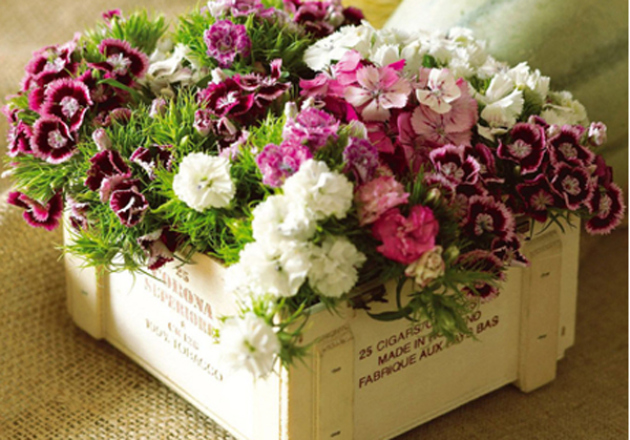

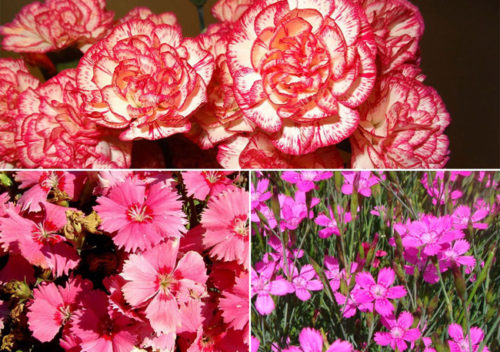
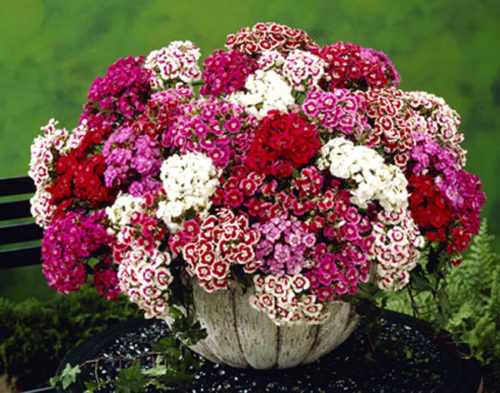
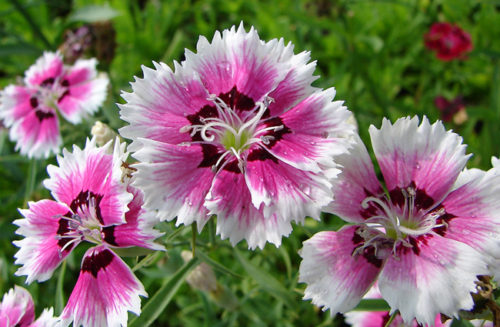
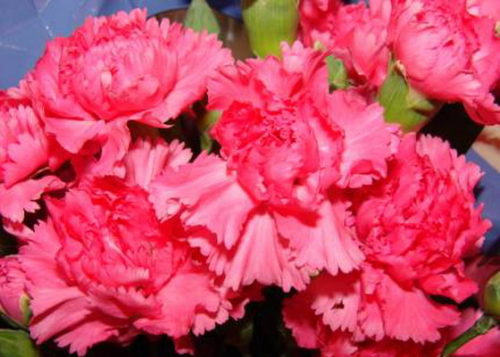

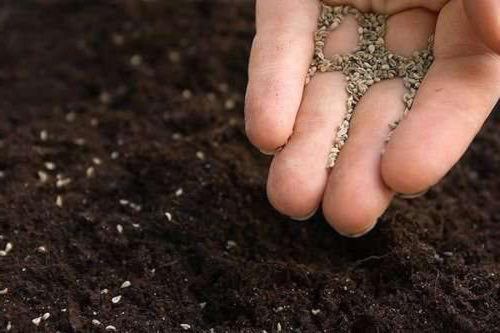
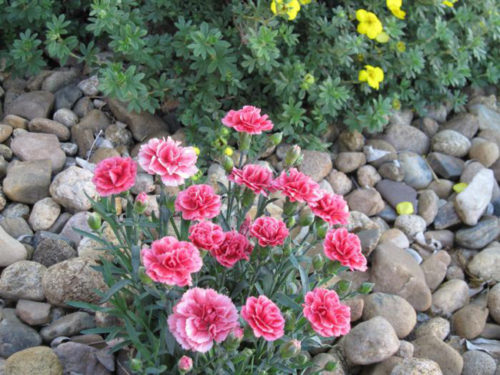
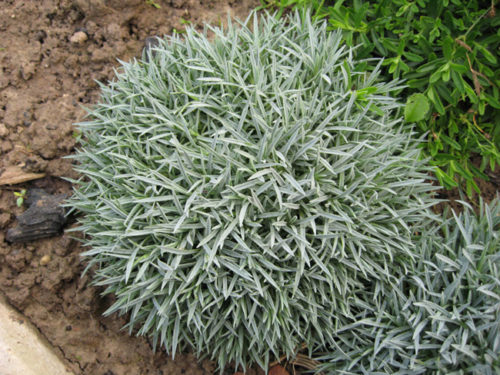
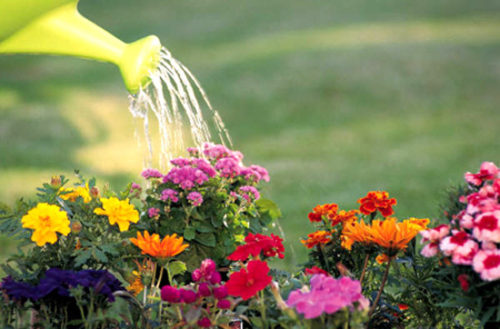
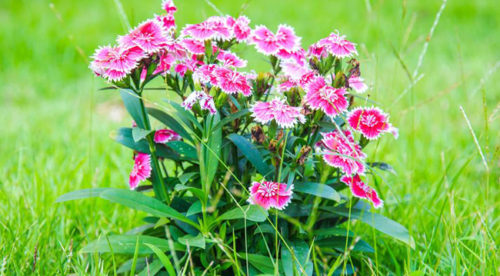
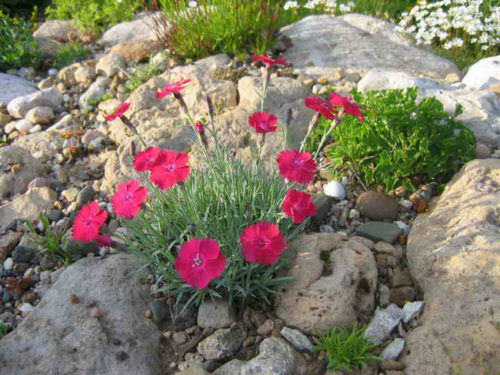












 Start a discussion ...
Start a discussion ...